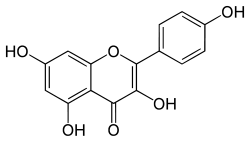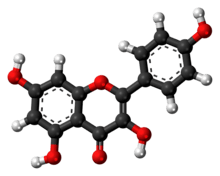Kaempferol
 | |
 | |
| Names | |
|---|---|
| IUPAC name
3,5,7-Trihydroxy-2-(4-hydroxyphenyl)-4H-chromen-4-one | |
| Preferred IUPAC name
3,5,7-trihydroxy-2-(4-hydroxyphenyl)-4H-1-benzopyran-4-one | |
| Other names
Kaempherol; Robigenin; Pelargidenolon; Rhamnolutein; Rhamnolutin; Populnetin; Trifolitin; Kempferol; Swartziol | |
| Identifiers | |
3D model (JSmol) |
|
| ChEBI | |
| ChEMBL | |
| ChemSpider | |
| ECHA InfoCard | 100.007.535 |
| KEGG | |
PubChem CID |
|
| |
| Properties | |
| C15H10O6 | |
| Molar mass | 286.23 g/mol |
| Density | 1.688 g/mL |
| Melting point | 276–278 °C |
Except where otherwise noted, data are given for materials in their standard state (at 25 °C [77 °F], 100 kPa). | |
| Infobox references | |
Kaempferol (3,4′,5,7-tetrahydroxyflavone) is a natural flavonol, a type of flavonoid, found in a variety of plants and plant-derived foods. Kaempferol is a yellow crystalline solid with a melting point of 276–278 °C (529–532 °F). It is slightly soluble in water and highly soluble in hot ethanol, ethers, and DMSO. Kaempferol acts as an antioxidant by reducing oxidative stress. Many studies suggest that consuming kaempferol may reduce the risk of various cancers, and it is currently under consideration as a possible cancer treatment . It is named for 17th-century German naturalist Engelbert Kaempfer.[1]
Natural occurrence
Kaempferol is a secondary metabolite found in many plants, plant-derived foods, and traditional medicines.[2]
In plants and food
Kaempferol is common in Pteridophyta, Pinophyta and Angiospermae. Within Pteridophyta and Pinophyta, kaempferol has been found in diverse families. Kaempferol has also been identified in both Dicotyledons and Monocotyledons of Angiosperms.[2] The total average intake of flavonols and flavones in a normal diet is estimated as 23 mg/day, to which kaempferol contributes approximately 17%.[3] Common foods that contain kaempferol include: apples,[4] grapes,[4] tomatoes,[4] green tea,[4] potatoes,[3] onions,[2] broccoli,[2] Brussels sprouts,[2] squash,[2] cucumbers,[2] lettuce,[2] green beans,[2] peaches,[2] blackberries,[2] raspberries,[2] and spinach.[2] Plants that are known to contain kaempferol include Aloe vera,[2] Coccinia grandis,[2] Cuscuta chinensis,[5] Euphorbia pekinensis,[2] Glycine max,[2] Hypericum perforatum,[2] Pinus sylvestris,[6] Moringa oleifera,[7] Rosmarinus officinalis,[2] Sambucus nigra,[2] and Toona sinensis,[2] and Ilex.[2] It also is present in endive.[8]
Biosynthesis
The biosynthesis of kaempferol occurs in four major steps:[2]
- Phenylalanine is converted into 4-coumaroyl-CoA
- 4-coumaroyl-CoA combines with three molecules of malonyl-coA to form naringenin chalcone (tetrahydroxychalcone) through the action of the enzyme chalcone synthase
- Naringenin chalcone is converted to naringenin and then a hydroxyl group is added to form dihydrokaempferol
- Dihydrokaempferol has a double bond introduced into it to form kaempferol
The amino acid phenylalanine is formed from the Shikimate pathway, which is the pathway that plants use in order to make aromatic amino acids. This pathway is located in the plant plastid, and is the entry to the biosynthesis of phenylpropanoids.[9]
The phenylpropanoid pathway is the pathway that converts phenylalanine into tetrahydroxychalcone. Flavonols, including kaempferol, are products of this pathway.[10]
Pharmacokinetics
Kaempferol is ingested as a glycoside, absorbed in the small intestine, usually by passive diffusion due to kaempferol’s lipophilicity, and metabolized in various areas of the body. In the small intestine, kaempferol is metabolized to glucuronides and sulfoconjugates by intestinal enzymes. It can also be metabolized by colon microflora which can hydrolyze the glycosides to aglycones or form simple phenolic compounds. These compounds can be absorbed or excreted. Kaempferol is also extensively metabolized in the liver to form glucurono-conjugated and sulfo-conjugated forms. These forms of kaempferol, and kaempferol itself, can then be excreted in urine. About 2.5% of kaempferol ingested is excreted as urine. Much of the rest of ingested kaempferol is present in the plasma and tissues in nanomolar concentrations.[2]
Potential pharmacology
Numerous preclinical studies have shown kaempferol and some glycosides of kaempferol have a wide range of pharmacological activities, including antioxidant, anti-inflammatory, antimicrobial, anticancer, cardioprotective, neuroprotective, antidiabetic, antiosteoporotic, estrogenic/antiestrogenic, anxiolytic, analgesic, and antiallergic activities.[2]
Anti-cancer effects
In vitro studies along with some animal testing has demonstrated the wide range of potential anti-cancer properties of kaempferol. It has been shown in malignant cancer cells to interrupt cell growth, limit angiogenesis, induce apoptosis, and to reduce their available energy and ability to metastasize. Kaempferol has also been shown to reduce MMP-3 protein activity inferring potential ability to reduce metastasis.[2]
Breast cancer
Estrogen receptors are important in both maintaining a normal mammary gland, and in the development of primary and secondary breast cancer. Kaempferol has been shown to interact with the estrogen receptor pathway and alter signaling in order to help slow growth. This compound exhibits ability to lower levels of Aromatase.[11] Kaempferol has also been found to induce apoptosis in breast cancer cells through extracellular signal-regulated kinase ½ activation [12] and up-regulation of p53.[2]
Ovarian cancer
Available evidence has shown that kaempferol can “inhibit VEGF production and suppress ovarian cancer cell metastasis in vitro”.[13]
Leukemia
Kaempferol has been shown to reduce growth in pro-myelocytic leukemia cells through altering the cell cycle.[14]
Bladder, prostate, and colorectal cancer
Various studies have shown that intake of kaempferol containing foods is not significantly associated with decreased bladder cancer, prostate cancer, or colorectal cancer risk.[2]
Gastric cancer
A case controlled study found that “consumption of kaempferol-containing foods was associated with a reduced gastric cancer risk”.[2]
Pancreatic cancer
An eight-year study found the consumption of three flavonols (kaempferol, quercetin, and myricetin) correlated with a lower risk of pancreatic cancer among current smokers, but not non-smokers or ex-smokers.[15]
Lung cancer
In A549 lung cancer cells, kaempferol up-regulated pro-apoptotic bax and bad genes, while it down-regulated anti-apoptotic bcl-2 and bcl-xL expression. This resulted in an increase in apoptosis of the cancer cells.[4]
Diabetes
A correlation was found between increased levels of kaempferol in the diet and a reduced relative risk of type 2 diabetes in a cohort study in 2005.[2] Additionally, 6-methoxykaempferol-3-O-β-D-robinobioside was shown to have significant inhibitory activity of aldose reductase, which plays an important role in diabetic complications.[16]
Cardiovascular disorders
A cohort study in men showed that consumption of flavonoid containing food decreased the risk of mortality from coronary heart disease. Another cohort study showed that high intake of tea is inversely associated with myocardial infarction.[2] Kaempferol has also been shown to have a protective effect on the apoptosis induced by the ischemia/reperfusion of cardiac cells. Due to this, it has a promising pharmacological role in preventing cardiovascular disease.[17]
Anti-bacterial activity
In a four-week study, kaempferol and its glycosides decreased the number of Helicobacter pylori colonies in gerbils. It also has been shown to work synergistically with antibiotics.[2]
Anti-viral activity
Kaempferol has been shown to inhibit or decrease the activity of enzymes that partake in viral infection such as reverse transcriptase, viral proteases and neuraminidase.[2]
Antioxidant effects
Kaempferol has been shown to have an array of antioxidant effects in vitro and in vivo. At low concentrations, its acts as a super-oxide scavenger, specifically against the highly reactive hydroxyl radical and peroxynitrite species. At high concentrations it increases the activity or expression of antioxidant enzymes such as superoxide dismutase, catalase, and heme oxygenase-1. Kaempferol can prevent the oxidation of low-density lipid proteins indicating a potential protective role in atherosclerosis.[2]
Notes
- ↑ Kaempferol at Merriam-Webster.com; retrieved October 20, 2017
- 1 2 3 4 5 6 7 8 9 10 11 12 13 14 15 16 17 18 19 20 21 22 23 24 25 26 27 28 29 30 31 32 33 34 Calderón-Montaño JM, Burgos-Morón E, Pérez-Guerrero C, López-Lázaro M (April 2011). "A review on the dietary flavonoid kaempferol". Mini Reviews in Medicinal Chemistry. 11 (4): 298–344. doi:10.2174/138955711795305335. PMID 21428901.
- 1 2 Liu RH (May 2013). "Health-promoting components of fruits and vegetables in the diet". Advances in Nutrition. 4 (3): 384S–92S. doi:10.3945/an.112.003517. PMC 3650511. PMID 23674808.
- 1 2 3 4 5 Kim SH, Choi KC (December 2013). "Anti-cancer Effect and Underlying Mechanism(s) of Kaempferol, a Phytoestrogen, on the Regulation of Apoptosis in Diverse Cancer Cell Models". Toxicological Research. 29 (4): 229–34. doi:10.5487/TR.2013.29.4.229. PMC 3936174. PMID 24578792.
- ↑ Donnapee S, Li J, Yang X, Ge AH, Donkor PO, Gao XM, Chang YX (November 2014). "Cuscuta chinensis Lam.: A systematic review on ethnopharmacology, phytochemistry and pharmacology of an important traditional herbal medicine". Journal of Ethnopharmacology. 157 (C): 292–308. doi:10.1016/j.jep.2014.09.032. PMID 25281912.
- ↑ de la Luz Cádiz-Gurrea M, Fernández-Arroyo S, Segura-Carretero A (November 2014). "Pine bark and green tea concentrated extracts: antioxidant activity and comprehensive characterization of bioactive compounds by HPLC-ESI-QTOF-MS". International Journal of Molecular Sciences. 15 (11): 20382–402. doi:10.3390/ijms151120382. PMC 4264173. PMID 25383680.
- ↑ Anwar F, Latif S, Ashraf M, Gilani AH (January 2007). "Moringa oleifera: a food plant with multiple medicinal uses". Phytotherapy Research. 21 (1): 17–25. doi:10.1002/ptr.2023. PMID 17089328.
- ↑ DuPont MS, Day AJ, Bennett RN, Mellon FA, Kroon PA (June 2004). "Absorption of kaempferol from endive, a source of kaempferol-3-glucuronide, in humans". European Journal of Clinical Nutrition. 58 (6): 947–54. doi:10.1038/sj.ejcn.1601916. PMID 15164116.
- ↑ Vogt T (January 2010). "Phenylpropanoid biosynthesis". Molecular Plant. 3 (1): 2–20. doi:10.1093/mp/ssp106. PMID 20035037.
- ↑ Flamini R, Mattivi F, De Rosso M, Arapitsas P, Bavaresco L (September 2013). "Advanced knowledge of three important classes of grape phenolics: anthocyanins, stilbenes and flavonols". International Journal of Molecular Sciences. 14 (10): 19651–69. doi:10.3390/ijms141019651. PMC 3821578. PMID 24084717.
- ↑ Wang C, Mäkelä T, Hase T, Adlercreutz H, Kurzer MS (August 1994). "Lignans and flavonoids inhibit aromatase enzyme in human preadipocytes". The Journal of Steroid Biochemistry and Molecular Biology. 50 (3–4): 205–12. doi:10.1016/0960-0760(94)90030-2. PMID 8049151.
- ↑ Aiyer HS, Warri AM, Woode DR, Hilakivi-Clarke L, Clarke R (June 2012). "Influence of berry polyphenols on receptor signaling and cell-death pathways: implications for breast cancer prevention". Journal of Agricultural and Food Chemistry. 60 (23): 5693–708. doi:10.1021/jf204084f. PMC 3383353. PMID 22300613.
- ↑ Chen SS, Michael A, Butler-Manuel SA (January 2012). "Advances in the treatment of ovarian cancer: a potential role of antiinflammatory phytochemicals". Discovery Medicine. 13 (68): 7–17. PMID 22284780.
- ↑ Jaganathan SK, Mandal M (2009). "Antiproliferative effects of honey and of its polyphenols: a review". Journal of Biomedicine & Biotechnology. 2009: 830616. doi:10.1155/2009/830616. PMC 2712839. PMID 19636435.
- ↑ Nöthlings U, Murphy SP, Wilkens LR, Henderson BE, Kolonel LN (October 2007). "Flavonols and pancreatic cancer risk: the multiethnic cohort study". American Journal of Epidemiology. 166 (8): 924–31. doi:10.1093/aje/kwm172. PMID 17690219.
- ↑ Veeresham C, Rama Rao A, Asres K (March 2014). "Aldose reductase inhibitors of plant origin". Phytotherapy Research. 28 (3): 317–33. doi:10.1002/ptr.5000. PMID 23674239.
- ↑ Khalil MI, Sulaiman SA (2010). "The potential role of honey and its polyphenols in preventing heart diseases: a review". African Journal of Traditional, Complementary and Alternative Medicines. 7 (4): 315–21. PMC 3005390. PMID 21731163.
External links

- Flavonoid composition of tea: Comparison of black and green teas